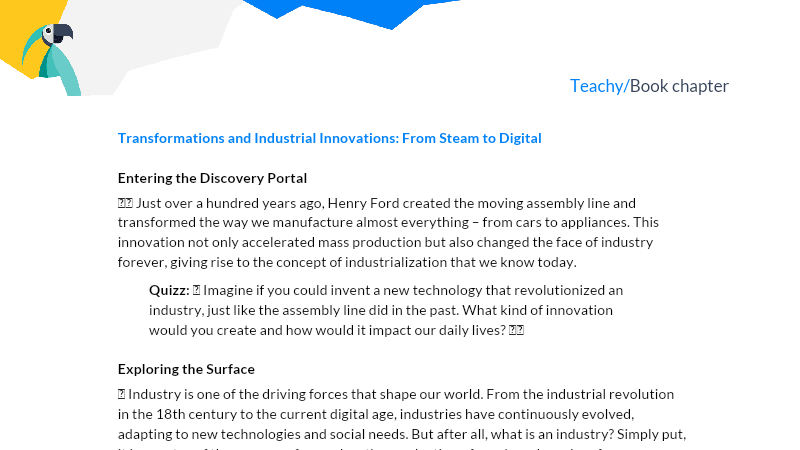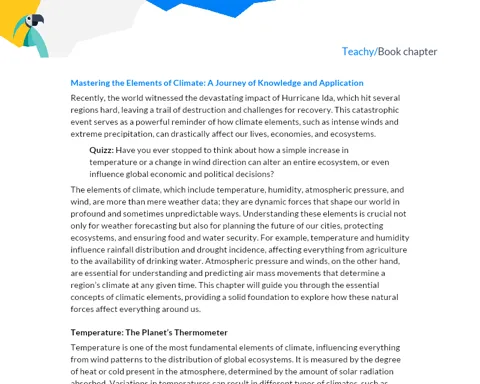Unveiling the Secrets of Weather and Climate
🌦️ 'Today, when I left the house, I noticed that the sky was bluer than yesterday, and the wind was gently blowing, making the leaves of the trees dance. But the weather forecast said we might have rain by the end of the afternoon. How do they know that?' 🌧️
Quizz: How can what happens in the sky or in nature influence what we do during the day? Have you ever stopped to think about it?
Meteorology, which studies atmospheric phenomena, and climatology, which analyzes climate patterns over time, are branches of Geography that help us understand and predict the weather. These studies are essential because the weather influences almost all our daily activities. From deciding whether to play in the park or study at home to more complex activities like farming or deciding whether a plane can safely take off.
Understanding the rhythms of nature, such as rain, wind, and heat, is fundamental for us to prepare and adapt. For example, farmers need to know when it will rain to plan their crops, and residents of hurricane-prone areas must pay attention to forecasts to ensure their safety. Moreover, understanding the climate of a place can help us comprehend the geographical characteristics and the lives of the people who inhabit there.
In this chapter, we will explore how these concepts relate to our daily lives and how we can observe and interpret the signs of nature around us. Together, we will discover how to make simple forecasts based on observation and collected data, laying the groundwork for practical activities that will make us true explorers of climate and weather!
Understanding Meteorology
Meteorology is the scientific study of atmospheric phenomena that affect the Earth, such as rain, wind, snow, and sun. Using methods such as observation, measurement, and data analysis, meteorologists can predict the weather with increasing accuracy. These forecasts are fundamental for various areas, from agriculture, which relies on the climate for planting and harvesting, to aviation, which needs safe information for flights.
Often, we hear about 'climate' and 'weather.' Climate refers to the average weather conditions of a region over a period of time, while weather describes the state of the atmosphere at a given moment. Understanding these definitions helps us realize why it is important to know if it will rain tomorrow or if the region where you live is warmer in summer.
Additionally, modern meteorology utilizes advanced technologies such as satellites, radars, and supercomputers that process enormous amounts of data to make predictions. These tools not only allow for forecasting the weather days in advance but also enable tracking and studying extreme weather phenomena such as hurricanes and tornadoes, increasing safety and preparedness for natural disasters.
Proposed Activity: Weather Journal
Create a weather journal! For one week, note the weather every day in a notebook. Describe the sky (sunny, cloudy, rainy) and the temperature. Compare your notes with what meteorologists say in the newspaper or on the internet.
Impact of Climate on Daily Life
Climate has a profound impact on our lives, influencing everything from what we wear to the activities we can engage in. For example, on warmer days, we might choose lighter clothing and outdoor activities, while on cold days, we need warmer clothes and may plan activities indoors.
Additionally, extreme weather events such as storms or heatwaves can affect the safety and infrastructure of cities. This is why governments and public safety organizations closely monitor the climate to alert the population and take preventive measures when necessary.
Globally, climate change is becoming an increasingly urgent concern, affecting not only local climates but also climate patterns worldwide. These changes can lead to resource crises, such as water shortages and changes in food production, directly impacting the lives of billions of people.
Proposed Activity: Climate and Daily Life
Discuss with your family how the weather affects your daily activities. Ask if they have ever had to change plans because of the weather and how they adapted. Write down the answers and share them in class.
Weather Forecasting and Its Tools
Weather forecasting is essential for planning ahead, whether for an outdoor event, a trip, or more critical decisions like evacuations in case of impending hurricanes. These forecasts are made based on mathematical models that analyze atmospheric data collected from various sources, such as weather balloons and satellites.
Meteorologists use various instruments to gather meteorological data, such as thermometers, barometers, hygrometers, and anemometers. These instruments measure temperature, atmospheric pressure, humidity, and wind speed, providing crucial information to understand atmospheric dynamics and make more accurate predictions.
In addition to traditional instruments, modern technology has brought innovations like weather radars, which allow real-time visualization of cloud formation and precipitation occurrences. These tools not only improve forecasting accuracy but also help issue early warnings about storms and other dangerous meteorological phenomena.
Proposed Activity: Exploring Meteorological Instruments
Research one of the meteorological instruments mentioned (thermometer, barometer, hygrometer, or anemometer). Create an explanatory poster about how it works and why it is important for weather forecasting.
Climate and Geography: A Fundamental Connection
Geography and climate are intrinsically linked. The climate of a region is determined by its geographic location, altitude, proximity to oceans, among other factors. For instance, regions close to the equator tend to have warmer climates, while polar regions are cold due to the tilt of the Earth's axis to the Sun.
This relationship is not just theoretical; it has significant practical implications. For example, climate directly affects vegetation and animal life in a region, which in turn influences economic activities and the lifestyle of the people living there. This is known as a biome, which describes the biological communities that develop in response to a particular climate.
Understanding these connections can aid in urban planning, sustainable development, and environmental conservation. Therefore, geographical studies often include climate analyses to better understand how global climate changes can affect different parts of the world in distinct ways.
Proposed Activity: Climate Around the World
Choose a country on the globe and research its climate, geographic location, and how the climate influences the lives of people there. Prepare a presentation to share this information with the class.
Summary
- Meteorology studies atmospheric phenomena and allows for accurate weather predictions, essential for various human activities.
- Differentiating between climate and weather is crucial: climate refers to long-term meteorological patterns, while weather describes the current state of the atmosphere.
- Modern meteorological technology, including satellites and supercomputers, has revolutionized forecasting accuracy, enhancing safety and efficiency in many areas.
- The impact of climate on our lives is immense, influencing everything from what we wear to critical public safety decisions in cases of extreme weather events.
- Global climate change is an increasingly growing concern, affecting climate patterns and vital resources worldwide.
- Instruments such as thermometers, barometers, and anemometers are essential for collecting meteorological data, forming the basis for weather predictions.
- The relationship between geography and climate is profound, influencing biomes, economic activities, and people's lifestyles.
Reflections
- How do weather forecasts influence your daily decisions? Think about how you plan your day based on weather information.
- Reflect on the long-term impact of climate change on communities and the planet's biodiversity.
- What is the importance of understanding and respecting the role of geography in climate for urban planning and environmental protection?
- In what ways can technology continue to improve weather predictions and preparation for natural disasters?
Assessing Your Understanding
- Conduct a climate observation project at your school for one month, recording data such as temperature, humidity, and types of clouds daily. Discuss the results in class.
- Develop a group debate about the impact of climate change on different biomes around the world, utilizing the knowledge of geography and climate gained.
- Organize a science fair at school focusing on meteorological technology, where students can present models of meteorological instruments and discuss their importance.
- Create an educational video to teach younger children about the difference between climate and weather, using practical examples from everyday life.
- Develop a sustainable action plan for your school community, considering how knowledge of climate and geography can help reduce environmental impact.
Conclusion
🌍 Exploring the Mysteries of Weather and Climate 🌦️
Congratulations on completing this journey of discovery about weather and climate! Now that you have a solid foundation in meteorology, the impact of climate on daily life, and the tools used to predict the weather, it's time to apply this knowledge in a practical and interactive way. In the next class, you will have the opportunity to become a true young meteorologist, applying what you've learned to make weather predictions and exploring how climatic phenomena influence our daily lives. Be prepared to actively participate, share your ideas, and learn from your peers. Remember, observation and curiosity are your best allies in the quest to understand and predict the climate around you. 🌪️🌤️
Before the class, review the concepts discussed in this chapter and think about how practical activities can help solidify your understanding. Get ready to question, explore, and most importantly, have fun while learning. We are looking forward to seeing the weather predictions you and your classmates create together!



